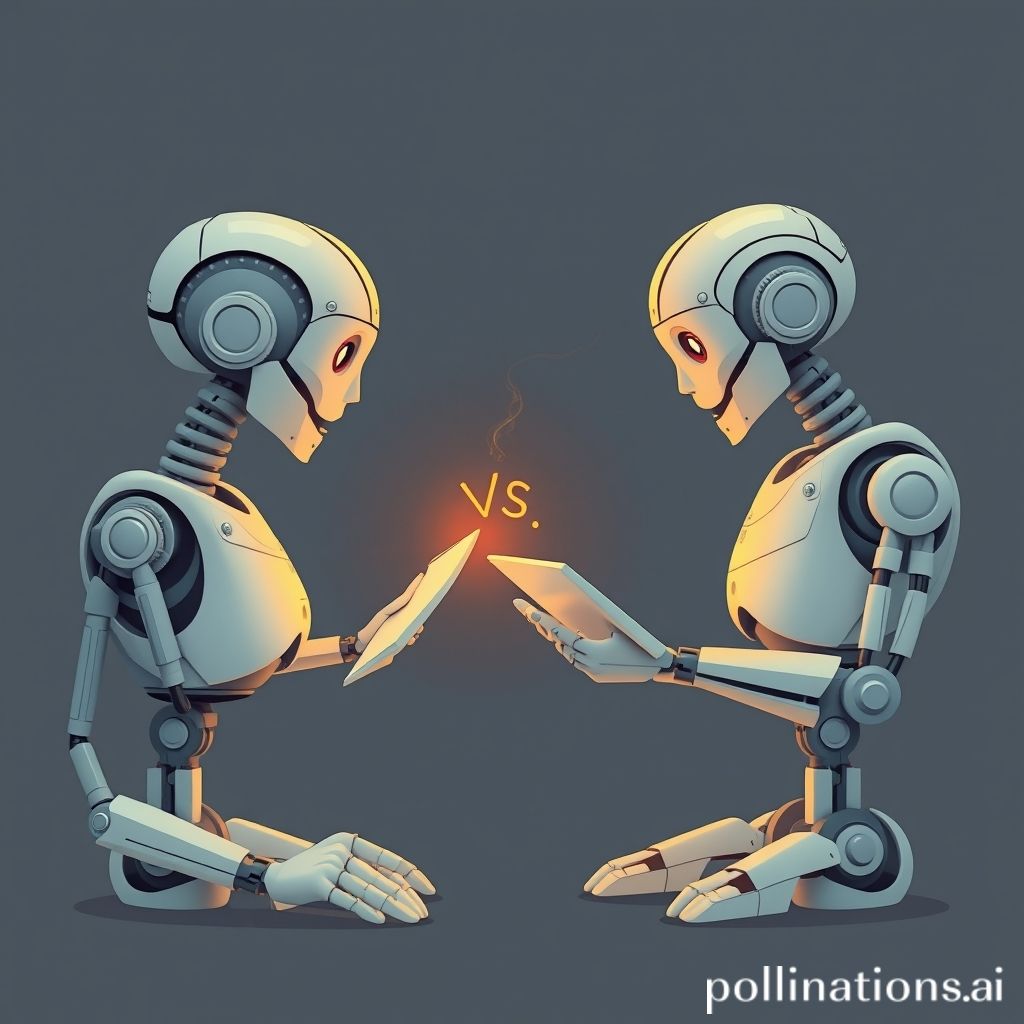Table of Contents
- Introduction
- Understanding Turnitin’s capabilities: What it can and can’t do
- The mechanics of AI-generated content and how it differs from human writing
- Current limitations in AI content detection: What slips through the cracks
- AI-powered tools vs. Turnitin: A head-to-head comparison
- Common misconceptions about AI detection in plagiarism software
- Strategies for educators to identify AI-generated content
- The ethical implications of using AI writers in academia
- Future advancements: Will Turnitin get smarter with AI detection?
- Conclusion
- Frequently Asked Questions
Introduction
In an era where artificial intelligence is transforming every nook and cranny of our lives, the war between AI-powered writing tools and plagiarism detection software like Turnitin is heating up. The question on everyone’s mind: Can Turnitin, a veteran in academic integrity, keep up with the sophisticated and ever-evolving AI writing technologies?
Imagine a world where students can effortlessly generate essays at the click of a button, while teachers scramble to discern between human and machine-generated content. The implications are both thrilling and terrifying. Will AI writing become the ultimate academic loophole, or will Turnitin’s advanced algorithms prevail in maintaining scholarly honesty?
In this article, we’ll delve deep into the mechanics of both AI writing tools and Turnitin’s detection systems, examining their strengths, weaknesses, and the ongoing battle of wits between them. Buckle up as we uncover the truth behind this high-stakes digital duel.
Understanding Turnitin’s capabilities: What it can and can’t do
Turnitin, a well-known plagiarism detection service, works like an eagle eye in the realm of academic writing. Oh boy, it’s good at catching those sneaky copied paragraphs and phrases from all corners of the internet and vast databases. As students sit biting their nails, wondering if their borrowed sentences will fly under the radar, Turnitin is sharpening its claws.
Now, let’s chat about what Turnitin can do. It can compare your paper to a colossal amount of content, be it from student papers or web pages. This giant digital detective can highlight exact matches, near matches, and even paraphrased segments, bringing them to light like fireflies in the dark.
However, what it can’t do is spot AI writing with absolute certainty. When it comes to sophisticated AI-generated text, Turnitin might scratch its head. It can sometimes detect patterns that hint at non-human origins, but it’s not foolproof. It’s like a metal detector at the beach; it finds most treasures but occasionally misses a buried gem.
In short, Turnitin’s powers are vast but not limitless. As technology dances on, the line between human and AI creation will keep shifting, leaving Turnitin trying to stay in step.
The mechanics of AI-generated content and how it differs from human writing
AI-generated content works like a well-oiled machine, churning out text based on patterns and data it’s been fed. Unlike a human writer, who pours emotion, humor, and quirky turns of phrases into their work, an AI’s content often feels a bit robotic. Let’s take a stroll down memory lane—the first time you read a captivating novel. Remember that rush of excitement and those unexpected plot twists? That’s the hallmark of human creativity. AI, on the other hand, may deliver information but seldom with a soul. It’s like getting a cake without icing—functional but missing that sweet touch.
Human writing sways, dances, and sometimes stumbles, adding a sprinkle of imperfection that’s endearing. AI-generated content, however, is as precise as a clock, ticking away without hesitation. For instance, if you asked an AI to write a love letter, it would hit all the right notes but lack the genuine warmth. It’s like the difference between a store-bought card and a handwritten note; one is universally pleasing but the other carries sentimental value. This dichotomy is what sets human writers apart from their AI counterparts, even if the latter can mimic human styles to a tee.
Current limitations in AI content detection: What slips through the cracks
Sure, Turnitin is a sharp cookie when it comes to sniffing out plagiarized work, but, oh boy, it’s not without its Achilles’ heel! Current limitations in AI content detection can be quite the Pandora’s box. For one, AI-generated text can often slip through the cracks if it’s mixed with human writing. Imagine a perfectly baked pie—a little artificial filling here and there, and who’s to know?
Furthermore, Turnitin typically looks for patterns based on existing databases of known texts, but AI writing can be a chameleon, blending seamlessly into new, unseen territory. Think of it as a shadow in a dark alley; it’s there, but good luck spotting it! Oh, the irony, right? There’s also the matter of evolving technology. As AI gets smarter, detecting it becomes a cat-and-mouse game; today’s safeguards might be tomorrow’s old hat.
Take the example of Jane, a diligent student who decided to use an AI tool to assist her with a complex essay. Turnitin flagged some sections but missed others, a testament to the current limitations. When all’s said and done, there’s a fine line between machined precision and human creativity, and it’s a line often blurred in the digital age.
AI-powered tools vs. Turnitin: A head-to-head comparison
Imagine a world where man and machine face off in a battle of intellect! Well, that’s what happens when we compare AI-powered tools to Turnitin. Turnitin, the old guard, has been a faithful watchdog, sniffing out plagiarism in student papers for years. It’s like that strict school principal who knows every trick in the book. But wait—enter AI tools, the new kids on the block, equipped with dazzling algorithms and futuristic capabilities. They’re like secret agents with fancy gadgets, ready to catch any misconduct in the blink of an eye.
Here’s the skinny: Turnitin excels at identifying similarities between submitted work and a massive database of previously recorded content. That’s its bread and butter. On the flip side, AI-powered tools bring a fresh pair of eyes to the game. They’re not just looking for copied text but can analyze writing styles, predict authorship, and even understand context.
Picture this: Turnitin as a seasoned detective with years of experience, while AI tools are more like young prodigies, quick on the uptake and always evolving. Both have their strengths and weaknesses, and choosing between them often boils down to what you value more: expertise or innovation!
Common misconceptions about AI detection in plagiarism software
Ah, the digital age! It’s got everyone buzzing about AI, especially when it comes to detection in plagiarism software like Turnitin. There’s a heap of common misconceptions floating around. One biggie? Folks think Turnitin’s a mind reader, catching AI-generated content with just a snap. Well, not exactly. While the software’s sharp as a tack, it’s not infallible. It’s designed to compare text to a vast database of sources, but AI-written text can sometimes slip through the cracks if it’s original enough.
Another myth? People often believe all AI writing sounds like a robotic parrot. Imagine that! Truth is, AI’s come a long way, crafting prose that’s as smooth as butter. This can make it tricky for software to flag but remember, the devil’s in the details. It’s all about nuances and patterns only a human eye can catch.
Then, there’s the tale that Turnitin’s solely reliant on algorithms, without any human oversight. Not quite! While algorithms are the front line, sometimes human reviewers pop in to double-check tricky submissions. Picture a modern-day Sherlock Holmes, uncovering clues that machines might miss.
Strategies for educators to identify AI-generated content
When it comes to spotting AI-generated content, educators need to be as sharp as a tack. First off, keep an eye out for text that’s too perfect. AI often creates writing that’s grammatically flawless but lacks the quirks of human touch. Inconsistencies in tone and style can be a dead giveaway too. Imagine reading a paper where the voice changes faster than a chameleon on a rainbow; that’s a red flag.
Teachers can also look for unusual patterns. AI writing often churns out repetitive phrases or an unnatural flow of ideas, like clockwork ticking a bit too predictably. Another handy trick? Throw in some context-specific questions during discussions. Human students, bless their hearts, might go off on tangents or show a bit of confusion—AI doesn’t, it sticks rigidly to its programming.
Compare assignments submitted by the same student. If one essay reads like Shakespeare and another like a basic grocery list, something fishy might be going on. Lastly, try using detection software like Turnitin’s AI features, designed to sniff out non-human input. These steps combined can help educators see through the fog, ensuring academic integrity shines as brightly as ever.
The ethical implications of using AI writers in academia
The ethical implications of using AI writers in academia are like walking on thin ice. On one hand, you've got the promise of convenience and time-saving. Oh, who wouldn’t want an AI to whip up a paper in minutes? But, on the flip side, there’s a dark cloud looming. Imagine, for instance, a student named Jane who’s juggling classes, a part-time job, and a social life. She turns to AI for help, thinking it'll be her knight in shining armor. Little does she know, relying too much on AI starts to erode her own skills and learning. With AI doing the heavy lifting, she misses out on developing critical thinking and writing skills that are crucial for her future.
Even more troubling is the question of integrity; using AI to write essays could be seen as cutting corners, even cheating. It's a murky area, sort of like a foggy night where you can't quite see the road ahead. You might think you're making headway, but are you really? The real kicker is the potential for academic dishonesty, as it blurs the line between what's genuine and what's artificial.
The ripple effects don't stop there. Educators are put in a pickle. How can they assess students accurately if they're not sure what's authentic? It's a slippery slope, one that could undermine the entire academic system if not tread carefully.
Future advancements: Will Turnitin get smarter with AI detection?
Imagine a future where Turnitin is not just a watchdog but an all-seeing detective, constantly evolving. The thought itself paints a picture of a digital Sherlock Holmes, sniffing out AI-generated content like a bloodhound on a scent. With technology moving at the speed of light, it’s a thrilling prospect.
As AI writing tools get craftier, it’s only natural for Turnitin to up its game. Think of it as a cat-and-mouse chase: each time AI gets a bit sneakier, Turnitin sharpens its claws and pounces back. You’re probably wondering, ‘Will it ever end?’ Probably not, but that’s where the magic lies.
In classrooms, it’s like a teacher who knows all the tricks in the book and then some. It’s those extra set of eyes, preventing students from cutting corners. The future might usher in systems that not only detect AI content but also understand context and intent, making it almost like having a conversation with the text.
Heck, one day we might even have Turnitin that can write poetry while checking your essay. Sounds wild, right? But who knows? The future is full of surprises, and with AI getting smarter, Turnitin is bound to follow suit.
Conclusion
Ultimately, while Turnitin and similar tools continue to evolve in their ability to detect AI-generated content, they’re not infallible. The article highlights the ongoing challenge of distinguishing between human and AI writing. It’s evident that as technology advances, so must our strategies for maintaining academic integrity. Those not leveraging cutting-edge tools, such as WPHorde, will find themselves at a disadvantage in this ever-evolving digital landscape.
Don’t get left behind. Equip yourself with WPHorde today and stay ahead of the curve.

